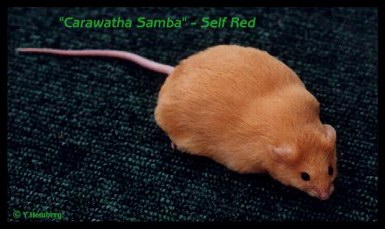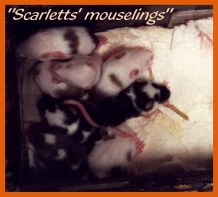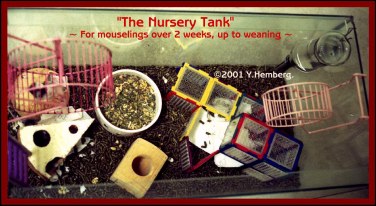CARAWATHA MICE
I originally had pet mice when I was in primary school. When my dad took me to get a couple of mice, the usual pet shop mistake ocurred, with us ending up with a pair instead of two girls. Well we didn't realise this at first, even after "Albino" my pew girl had babies, thinking that she must have gotten pregnant at the pet store. It wasn't until 3 weeks later when she had a second litter, that we got to thinking that something isn't right here. Even though we separated them the next day, "Scotch" had already mated her again, and a third litter followed another 3 weeks later.
"Scotch" was the most amazing mouse I've ever owned. He was my favorite pet. He was a longhair who's fur was really only fluffy rather than long, and he was five different colours. Black, White, Chocolate, a type or orangey colour, and cream. Many of his babies were tricolours, and there was even one that had four colours on it too.
However one day in the not too distant future, my dad decided that enough was enough, and took all the male mice and most of the females to the pet shop one day while I was at school, leaving me with 5 girls. I was devastated that "Scotch" was gone, but no amount of begging would make my father go back to the shop and get him. I have never seen a mouse like him since.
Many years later........
Carawatha Rodents started with mice in 1994 after helping a friend out, finding homes for his mousery mice when he had to move due to a promotion at work. He informed us that he'd had one of his Siamese girls (who we later christened "Thai") in breeding with a Siamese boy, and that she was probably pregnant. So we kept her to see if she was. Turned out we got rather attached to her, and after she had her litter we not only decided to keep her, but also a pair of her babies, "Siam" and "Zhar". These three Siamese mice were the foundation of our original Siamese line. Many from that line have travelled interstate. We took a break from breeding mice, between 2004 and 2008, only welcoming them back again in February of this year, 2008. I was delighted to obtain four marked siamese mice who's origins go back to the line we started with all those years ago.
Because we'd had to hang onto "Thai", we couldn't have her live alone now could we, especially in her condition, So we kept two other female mice for her companionship. They were a Chocolate Even marked girl we named "Cindi" and a self stone girl we named "Sharon Stone".
Now because "Sharon" was such an uncommon colour, and one that our friend had been working on for a while, we decided to keep a male stone coloured mouse too. I couldn't let this new colour slip away, when new varieties come along so seldomly. So we also kept the self stone boy "Old Stoney" and a companion for him in "Walt" a black&white Pied Tan male.
It was around this time, a friend invited us to join the recently started Queensland Mouse Club, and at a show one day we heard someone say that tricolour mice didn't exist. I found this hard to believe, after my first mouse and all his offspring, and the fact that I'd been breeding rats for the last decade with very little to do with mice, I figured, 'how hard could it be', so I set about trying to breed some more tricolour mice. It was during these trials that my love for marked tiger mice began, spawning the variety that is known today, as Calico.
A close friend of mine Tanya, who also bred rats, was often on the lookout for mice for me after I told her about this. With neither of us knowing a whole lot about mouse genetics at that time, over the ensuing 6 months she gave me three little mice she thought may be helpful in my quest for tricolours. A Tiger pair, we named "Tigah" and "Tigress", and a little female pied tan just like 'Walt', that we named "Disney".
I did actually manage to find two tricolour mice. One in a local pet shop who was an even mixture of dove, cream and white, we named her "Carly", who sadly, proved to be infertile. And a little longhair almost variegated female of the same three colours from a fellow breeder in the club, her name was "Multimice Tiffany". Tiffany did breed for us, however there were no more tri-colours in her litters. Of course now that we understand the genetics of mouse breeding, it's not surprising to us that we were unsuccessful in our quest.
However little "Tiffany" turned out to carry lots of recessives, it was from her babies that we started our Manx and longhair lines, that are also still around today, both here & interstate.
Over the years we've bred every colour and pattern of mouse available in Australia. At the beginning of 2000, we decided to concentrate on a select few breeds and colours, our favourites. These varieties were, Texels&Astrex, Manx, Longhairs, the Tiger varieties, Selfs in blue, silver & dark-eyed cream, Marked mice in Banded, Berkshire & Calico, Agouti's, and Shaded mice in Javanese, Balinese & Siamese. While this list may still sound long, it's a lot less than we used to have. 4 times this amount can be found in the official breed standard of the ANRA.
One variety I am particularly fond of is the self reds, fawns & creams. But due to the lethal nature of the genes causing these exquisite colours, they usually end up obese and dying of heart or other major organ failure. In the time we did breed these, we did reduce the mortality rate and increase the life span considerably, by outcrossing continuously. However as the obesity is the result of the dominant yellow gene in these mice, it cannot be bred out completely, and so our red/fawn lines ended with "Samba" in 1999.
The picture below is our Samba, at a time when she could still walk. She is only 6 months old in that photo and already weighing near the 70gram mark. We euthanased her at the age of nearly 11 months at a weight of just on 120grams.

Towards the end we put her in a home by herself. She could not walk much at all, only shuffling from the food dish to the water bottle. She made her bed each night between these two items. She had managed to rub all the fur off her tummy, so we had her bedded on pieces of cut up cloth made out of babies nappies. It got to the stage, where if you picked her up, her heart rate increasing just that little bit would cause her to have a funny little vague spell. When she was 10 months old she developed a tumour directly under her chin. It was pea-shaped and rock hard. We kept an even closer eye on her now, and nearly three weeks later she appeared to have one of her eyes half closed all the time. The vet informed us that this was more than likely due to the tumour. It was at this stage that we decided it would be kinder to let her go to heaven.
So that was the last we had to do with any Ay (Dominant lethal yellow) variety mice, instead sticking to the Avy (or Dominant viable yellow) varieties instead. The Tiger variety mice. Avy gene mice do often have weight problems, but this can be lessened with selective breeding and is not of the fatal nature like that of the Ay mice. Through outcrossing we managed to minimise the weight gain tendencies of these varieties. It looks very promising, the trait can be all but bred out.
When we breed our mice, we pay special attention to temperament as well as breeding towards improving the type, pattern or colour as per the standard. When we started in mice, the average mouse wasn't very good 'pet' quality. They were hard to handle, and seemingly impossible to tame. I'd hazard at a guess, by saying that around 1 in 50 would have had a good temperament. This problem was especially evident in the males. While testosterone is a key contributor to male aggression, it is by no means the only factor. This has been proved, when observing desexed males continuing to engage in fighting and hostile behaviour to one another. In general, desexing does calm most males down, but this is not an option if you want to breed with the mouse in question. Temperament is at least 50% hereditary.
Thankfully, through careful selection for sweet natures, the majority of our males would live with other males, even after they've been bred themselves. Of course good socialisation with both mice and people is essential for all mice, both male and female. Another good reason to breed only with good tempered mice is that mice that are flighty, nippy or unhandleable are more likely to hurt or kill their young if you disturb the nest. The mother mouse has to feel comfortable with you being around her babies. Mice usually make wonderful doting mothers, but instinct can kick in at the most inoportune time, and if your mouse is not comfortable enough with you then it's going to make handling and socialising the babies a risky exercise.
Mouse fathers also usually make for doting parents. However leaving the male in is not an option due to the fact that female mice have a postpartum oestrus (meaning they come into heat again at the time of birth) Some immediately after giving birth, and some just before giving birth. In which case an undesired pregnancy would be the result. If the male is housed with the pregnant female during her gestation, he may be observed following the female around with his nose where it's not wanted. A sure sign that she is not far off giving birth.
While the obvious reason for not leaving 'dad' in, is to prevent another pregnancy, there is the possibility that the mouselings may be injured or killed from being trodden on, while the male is busily trying to re-mate the female and there are cases where the male becomes aggravated with the babies getting in the way and may hurt or kill them for this reason, although from what I've heard this is rare.
We use a genetics approach to breeding in all regards not just temperament. The genetics of fancy mice today is largely well understood, with literature about this fairly easy to find. With selective breeding for type, pattern and colour improvement, each successive generation in a line is working towards improving that particular variety.

When breeding litters, it's best to have only one or two at a time. You need to be able to devote a lot of time to raising the babies. By raising, I mean, handling. We handle our babies initially the day of their birth, to check for milk-tummies, the sex of the bubs & just general observation. From around 5days of age, when they begin to get a peach-fuzz covering of fur, we spend some time each day, just holding them, allowing them to become accustomed to the smell and feel of human hands. This gentle handling consists basically of you simply holding them in a pile in both your hands, while you sit quietly. This can be done while watching the news even, household noises are also a good thing to get the little ones used to. This needs to be done at least once a day, even better if it can be done twice, morning & evening. This "holding" technique, allowing the mouselings to get used to your smell & the everyday sounds of the household will help them not to be so startled once they've opened their eyes. On a different note, I've observed that the mothers get used to the time of day & evening the babies are taken out, & seem to come to expect & appreciate the time by themselves. Keep the "holding" sessions to a maximum time of about half an hour only though. Young mouselings need to feed from their mothers often & shouldn't be kept away from the nest too long.
Strict breeding guidelines must be upheld, to ensure optimum conditions for the mice. Both Females & Males must be a minimum of 3 months old and weigh 20grams before they can be bred with and both sexes must be in good health and condition. They must also have a minimum rest period of 4 weeks between litters. This gives the mouse a maximum amount of 4 litters per year. While some may say that this is not a very high amount, if you break it down, you realise just how much it really is.
*Once the mouse falls pregnant, she will gestate for approx. 3 weeks, then she lactates for approx. 4-5 weeks, followed by a 4 week rest. Add this up and you get 3 months, so you see 4 litters a year really is a very full schedule for a mouse. We prefer for our females to have no more than 2 litters per year.
Pregnancy and Lactation take a lot of energy from the mother and they benefit greatly from dietary supplementation during the lactation period. We use wholemeal bread soaked in organic soy milk (vitasoy brand) and nutrigel a few times a week. Plus they get more protein and haem-iron based treats than they would normally.
We house our mother mice in their own special birthing cage before they are due to give birth. They stay in this area until the mouselings open their eyes and start to move around, which is usually around 2 weeks old.
At such time mother and babies are moved to one of our nursery tanks, where they will stay until they are sexed and/or rehomed. These nursery tanks have lots of toys, and activities to stimulate the young mice. Also a high up area where mum can get away from the babies if she wants to. Our nursery tanks are a minimum size of 24" x 12" x 12". This gives even a large litter plenty of room to move and play.
The majority of our mother mice, tend to wean their babies at around 3.5 to 4 weeks of age. It depends largely on the size of the litter as to the growth rate of the babies and the subsequent weaning age. Here is a good example of two extremes.
"C. Quizzie" a little marked Siamese we had, believed in quality rather than quantity. She gave birth 4 times, and each time, to only one baby. It was so hard even knowing if she had even fallen pregnant. This one baby was usually weaned at around the 3 week age, and by 4 weeks of age, was the size of a regular 8 week old mouse.
On the other end of the scale is "C.Chandon" a longhaired self champagne, who had litters with amounts in the high teens. One of her litters, of 17 were not fully weaned until they were 6 weeks old, and at that stage looked the right size for 5 week old mice.
Usually at around 3 weeks of age the baby mice are sampling mums food. At this stage we give them tinned Gerber brand toddler food once a day for them to pick at.
All our mouselings are wormed with small animal wormer after they have been weaned, and not before they're 5 weeks old.
We worm our mice with small animal wormer every 3 months and treat them with an ivomectin paste approximately once every 4 months as well, for more broad spectrum coverage of worms as well as to prevent any infestations of any type of mite or lice. We don't advise using ivomectin on mice under 8 weeks of age and always be precise with the dose-rates as over-dosing can be fatal.
It's important to note, that mice should not be wormed from the week before they're intended for breeding, right through the whole breeding cycle, until after the mouselings have been weaned.
To do so too close to breeding and/or while the doe is pregnant, can cause deformity in developing foetuses and/or in-utero death.
To do so while she is nursing can cause the death of the mouselings by filtering through to them through her milk. The babies systems at this age, are too immature to handle the drugs/chemicals used in worming preparations.
All Carawatha mice have papers, while many are fully pedigreed (4 or more generations not including themselves) mice that are not fully pedigreed still have a 1, 2 or 3 generation history data sheet.
All of our mice and our litters are registered with ANRA Qld. We also offer a breeders guarantee of hereditary soundness. Basically if we sell a mouse for show/breeding quality, then they will be of that quality. Likewise when we sell a pet, they are a well socialised pet mouse. We never sell any of our mice as feeders, nor any that would go as breeders who's babies will be feeders. If you have adopted a mouse from us, we ask to be notified in the event you wish to re-home or sell the mouse, as we usually will offer to take them back.
Our home of choice for our mice is aquariums with 5mm diameter wire mesh tops. We have found these to be the easiest to keep clean. In the winter months we also make use of habitrail systems. They hold in warmth really well, which is particularly good for the Sphynx mice (Hairless).
We have noticed that in general, mice feel the cold a lot more than rats do. Whereas rats appear to feel the heat more than mice. For this reason any litters we breed in the Winter months are kept inside the house with us at all times. With our states variable weather, we highly recommend the use of a reverse cycle air conditioner, to keep a constant year round temperature.
As bedding we use a number of pelletised types. Breeders Choice recycled paper pellets, Light'n'easy recycled paper bedding and sometimes Lucerne pellets, depending which one is on special :) In the past we have tried and subsequently found unsuitable and in some cases quite dangerous, Wheaten Chaff, Oaten chaff, wood shavings(as here they're all softwood) and poultry pellets. All our mice have their beds lined with Handee Ultra paper toweling & and thick toilet paper also, as they love to have something to shred & make a nest with. Material scraps are usually not suitable for this as small threads can become wrapped around small limbs & cut off circulation before you'll realise it's happened. When we started out with mice years ago, we used to use hardwood shavings for bedding, obtained from a carpenter/cabinet maker I was working for. They did a lot of work with solid wood, so we were gauranteed that the wood was of hardwood origin. However, I do not recommend the use of wood shavings at all, for any small animal/rodent, quite simply because so far, I've not found any manufacturers here in Australia that are willing to guarantee you in writing that their product is 100% hardwood.
Mice love toys and activity items to play in and on. Wooden & cardboard boxes, specially made plastic mouse houses and activity items, ladders, tunnels, empty toilet and paper towel rolls and of course the quintessetial running wheel. We use and recommend the silent runners. For your mouse's safety, your peace of mind as well as a noiseless mouse room.
Our mice enjoy a regular diet consisting of a dry mixture, the recipe of which has taken shape over the years; containing 7grains, rat&mouse cubes and premium lucerne, to which we add a quarter part of canary seed and budgie seed mixes. The all grain type mixes, not the types that have pelletised bits specifically for birds, a cup full of Nibble & Gnaw mix and probiotic powder. From time to time we also add various cereals & uncooked dry noodles.
Our mice also enjoy fresh fruit and veggies at least every second day, and as treats they get tidbits of what we eat, some of our leftovers and occasionally dried fish cat-treats. About once or twice a year we supplement their water with an echinacea tonic. Small animal vitamins added to their water every second week ensures they each get all the vitamins and minerals they need.
I trust you've enjoyed reading a bit about our beloved mice and how we run our mousery. I'm happy to chat to any mouse lover about all aspects of these wonderful little creatures, be it simply about how to care for your pet mouse, to showing, breeding or even more complicated genetic matters. Before becoming a mother myself, I worked as a Veterinary Nurse and being qualified in that field, am happy to discuss health issues also. Please do not email me in urgent situations though, as sometimes I don't get the opportunity to check email everyday. My number is located in a number of places on this website and I welcome phonecalls, otherwise I'd recommend calling a good rodent vet. We are lucky to have a very good rodent vet whom I can highly recommend. Dr Laryssa Ladyko at the Indooroopilly Vet Clinic (07.38789766). I also recommend Dr. Amanda Hullands-Nave at the Brighton Vet Clinic, who worked wonders with our "Chan", when she needed a ceasarian section.
<:3 )~~~ <:3 )~~~ <:3 )~~~ <:3 )~~~ <:3 )~~~ <:3 )~~~ <:3 )~~~




